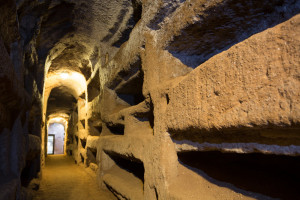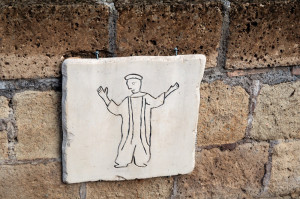The Layout of the Catacombs of San Callisto
 The Catacombs of San Callisto are the largest in Rome. They’re a complex of arcades and chambers that are about 90 acres in area and 12 miles long. The ceilings of the tunnels can be 70 feet high while less that six feet wide in some places.
The Catacombs of San Callisto are the largest in Rome. They’re a complex of arcades and chambers that are about 90 acres in area and 12 miles long. The ceilings of the tunnels can be 70 feet high while less that six feet wide in some places.
They’re the resting place of about 500,000 people including a number of early Popes, many early martyrs and a great many Christians. They were used not only as burial sites but secret places of worship while the Christians were being persecuted by Emperor Nero. Hence, all those martyrs. However, people continued to be buried in the catacombs even after the religion was decriminalized. The rough hewn burial niches held the bodies of athletes, carpenters, bakers, tailors and other rather ordinary folk who were allowed to die natural deaths.
One area of the catacombs holds graves of the Popes as well as the Crypt of Lucina and the grave of St. Cecilia, one of those early Christian martyrs who was put to gruesome death for her faith.
The area where St. Cecilia and the Popes are buried is called “of the sacraments” and has some of the catacomb’s oldest frescoes and family tombs.
Other ares of the Catacombs of San Callisto include the region of Sts. Gaius and Eusebius and a Libran region.
Origins of Catacombs of San Callisto
The Catacombs of San Callisto were created by the man who became Pope Callixtus I while he was still a priest. He built them on the orders of Pope Zephyrinus. Even though the catacombs are named after him, Callixtus isn’t buried there himself.
In the heyday of the catacombs there were actually 16 Popes buried there, but historians list the Popes now as:
• Pontian
• Anterus
• Fabian
• Lucius I
• Eutychian
There’s also an inscription dedicated to Pope Sixtus II. Other Popes mentioned are Dionysius, Cornelius, Felix, Melchiades, Stephan and Urban I.
Catacombs of San Callisto Frescoes
Though admittedly spooky in places, the catacombs are full of artwork, including frescoes that depict St. Cecilia at prayer, Pope Urban I and the bust of the redeemer. Other frescos seem to represent at least some of the Holy Sacraments, including Holy Communion and the Resurrection.
Because Christians had to worship in secret, many of the frescoes are full of symbols associated with Christ, such as The Good Shepherd, the dove, the fish, the alpha and the omega, the phoenix and the anchor and the monogram of Christ. This is the Greek letters chi and ro. If someone’s grave had this monogram, people knew they were Christian.

So make sure you put these breathtaking catacombs in your itinerary when you visit Rome. It’s truly an underground city, though admittedly not as noisy and bustling as the city above. The Catacombs of San Callisto are bound to be a highlight of your visit.

